The year is 2220. Everyone alive on Earth today is long dead, and the world looks very different. Desperate to study the atmospheres of the past, on a mission to understand how the hostile twenty-third century climate could unravel further, a scientist has travelled to the Antarctic hinterland. Her gloved hand pulls open a door buried in the snow. Behind it lies the top of a staircase, which spirals down into the freezing darkness. Flashlight in hand, she descends three stories to find history.
Inside a steel vault that has been sealed for more than a century, frost sparkles from steel canisters. They hold ice scraped from mighty glaciers that once topped the highest mountains. She has seen the glaciers in pictures, but now — thanks to forward-thinking predecessors — she has the chance to analyze them and their valuable record of the past. She breathes silent thanks to the glaciologists of the early twenty-first century who set up this archive.
Back in 2020, scientists are still racing to make this vision a reality. They are crisscrossing the globe, scaling peaks and drilling out lengthy sections of glacier ice while it still stands. Because time is dripping from the mountains. From the Alps to the Andes, glaciers that have stood for thousands of years are melting. And as the ice disappears, so does a unique archive. Locked within are traces of the atmosphere as it was when the glacier formed: bubbles of gas that indicate past levels of carbon dioxide, sulphur and nitrogen pollutants, and even specks of pollen. For scientists interested in ecosystems and climate, glacier ice is a vital repository of clues.
It’s probably too late to save most of the glaciers outside the polar regions; continuing greenhouse gas emissions and global warming will see to that over the next century or so.
“We need to preserve these really important archives because they are melting away,” says Margit Schwikowski, an environmental chemist at the Paul Scherrer Institute in Switzerland. “It’s really obvious if you go to the glaciers that they are suffering. It’s happening everywhere on Earth.”
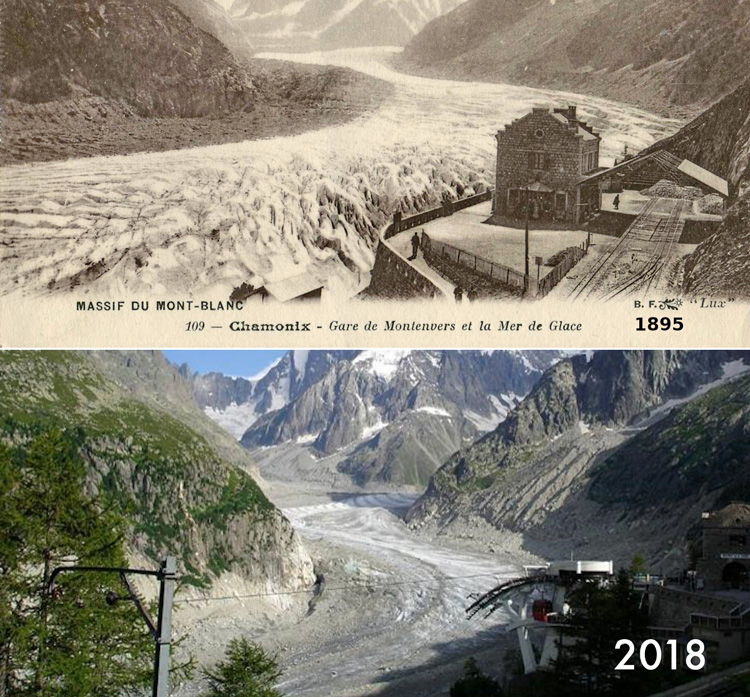
The Mer de Glace (or “Sea of Ice”) has retreated dramatically up its valley in the French Alps, as seen in these photographs from 1895 and 2018. As the ice melts, so too does its memory of the past — including what the environment was like at the time the ice formed.
CREDIT: COURTESY OF FONDATION UGA
Schwikowski is one of the leaders of an international project called Ice Memory, which aims to gather ice cores from disappearing glaciers and entomb them permanently in a snow-covered vault in Antarctica (which has been designed but not yet built). The idea is that Antarctica is Earth’s most enduring deep freeze, and so is the best place to store scientific ice cores over the long term.
There are other ice-core stores around the world. Freezers at universities and national facilities hold stockpiles of ice drilled from the polar regions and from mountain glaciers, which scientists can easily visit and study. But such stores are not always secure. In 2017, a freezer malfunction at the University of Alberta in Edmonton melted part of the largest collection of ice cores from the Canadian Arctic.
That’s where the idea of an Antarctic vault comes in. Since 2015, the Ice Memory team has drilled and retrieved ice cores from glaciers on four mountains: Mont Blanc in the French Alps, Nevado Illimani in Bolivia, Belukha in the Russian Altai, and Mount Elbrus in the Caucasus. These are secured in commercial freezers in Russia, France and Switzerland. The ultimate plan is to drill two or three cores from 20 to 30 glaciers. One core from each glacier would be analyzed now, and the others sent to permanent storage in Antarctica.
Technology used to analyze ice cores is advancing year after year, says Schwikowski, and so it’s reasonable to assume that experts in the future will have even more powerful tools. That will give them the chance to perform more sensitive analyses than are possible today.
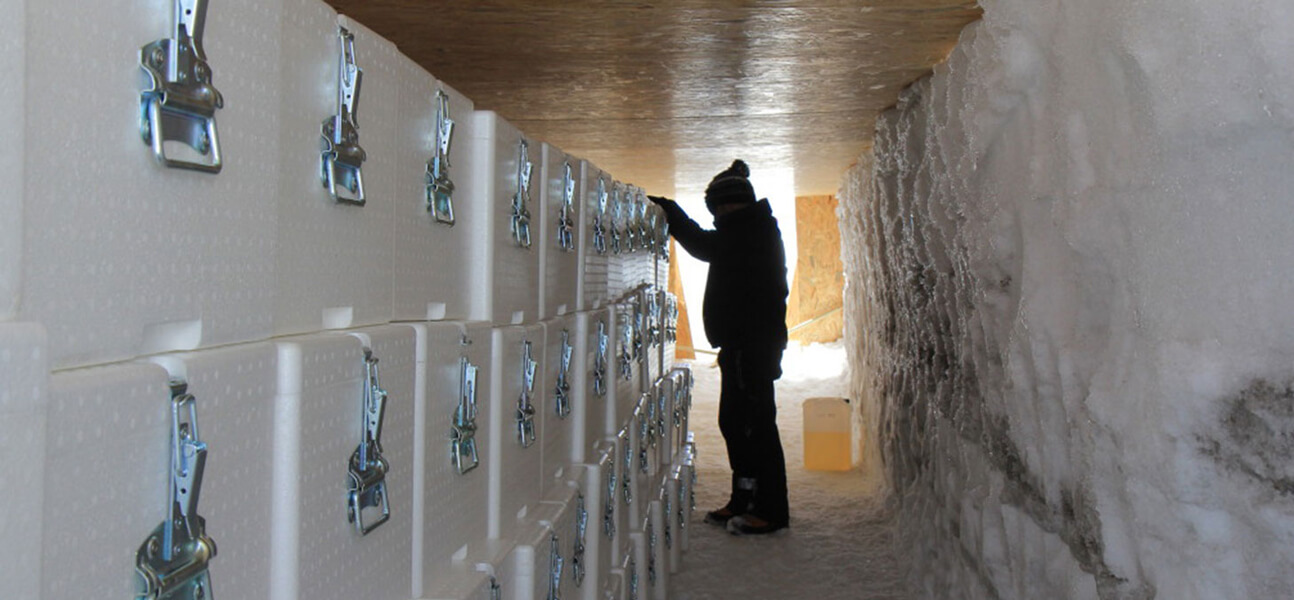
Ice Memory scientists want to ship ice cores drilled from vanishing mountain glaciers to Concordia station in Antarctica (shown), where they envision building a more secure subterranean deep freeze.
CREDIT: COURTESY OF FONDATION UGA
Stories from the past
Retrieving the ice is hard work. Drillers typically extract cylindrical sections of ice around 1 meter long and 10 centimeters wide (about 3 feet by 4 inches). Starting at the glacier surface, the scientists keep drilling and removing the sections, aiming to reach all the way down to the bedrock.
Working at altitude in these conditions is unpredictable. While drilling the second core from the Belukha glacier in 2018, the Ice Memory team hit a crevasse and had to stop early, 60 meters short of the bedrock. And the same year, the weather on Mount Elbrus was so bad that drilling on two cores had to be stopped, again before reaching the bedrock. “We just sat in our tents in a snowstorm for 10 days,” says Stanislav Kutuzov, a glaciologist at the Institute of Geography, Moscow, who was part of the expedition.
The deeper that scientists drill, the older the ice they retrieve. Ice cores retrieved from Antarctica carry information from as much as 800,000 years ago. Most mountain glacier ice, including cores drilled in the Alps, is believed to date back to the most recent ice age and so is up to about 5,000–10,000 years old.
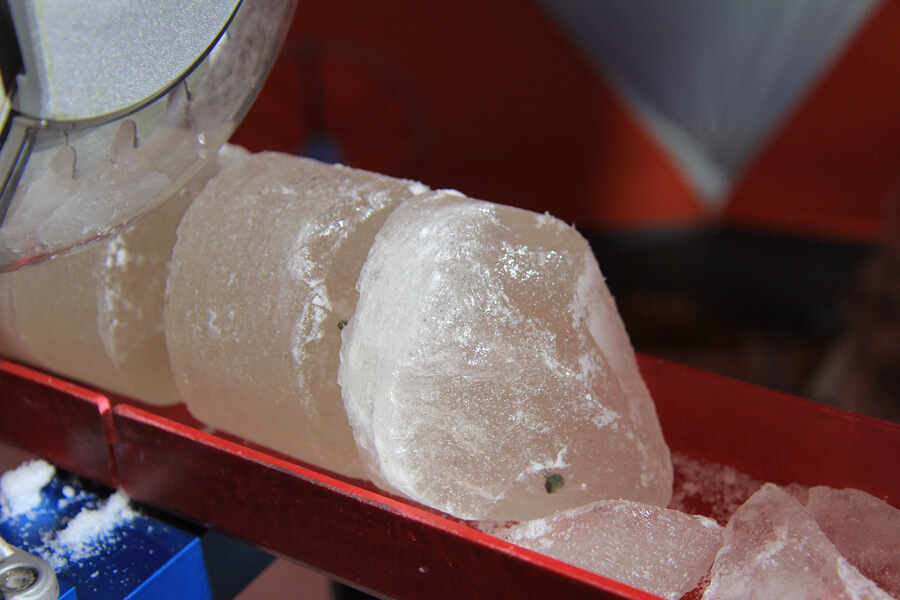
This ice core was sampled from Nevado Illimani mountain in Bolivia, where glaciers have been shrinking as temperatures rise. The international Ice Memory project drilled the core as part of its effort to collect and preserve the records of past climate that are found in glacier ice and are now threatened by global warming.
CREDIT: SARAH DEL BEN / WID TOUCH / FONDATION UGA
Most ice cores studied are from the poles and Greenland, because that older ice presents a longer term picture of the climate. But mountain glacier ice is particularly useful, Schwikowski says, because it reveals a picture of regional variation across the world, especially for particles of pollution that don’t tend to travel very far.
“Ice cores are an invaluable way to understand the past climate,” agrees Gavin Foster, a geochemist at the National Oceanography Centre at the University of Southampton, UK, who coauthored a 2018 Annual Review of Marine Science article on paleoclimate studies. “There seems to be no limit to what they can tell us about global and local conditions.”
For instance, in a study published last year, a team from Japan and Idaho analyzed pollen grains in an 87-meter-long ice core drilled in the Grigoriev Ice Cap in the Tien Shan Mountains of Central Asia. They found five different types of pollen, which fluctuated with the depth of the core. Because deeper ice is older, they could build a picture of how vegetation in the region changed over the last 220 years. The results indicated that grasslands have expanded near the ice cap, probably because of warmer temperatures and rainfall in the late twentieth century.
In another project, researchers from Germany, Denmark and Switzerland explored how many cloud-forming particles may have drifted through Arctic skies — an important unknown about past climates. The scientists melted ice from cores drilled from glacier and non-glacier ice in the Arctic, and then cooled these water drops to record the temperatures at which water from different depths in the ice re-froze. This revealed how many ice nucleating particles — dust, pollen, bacteria, fungal spores — were in the atmosphere over the past 500 years, and so how likely different types of clouds were to have formed.
Colder is safer
The Ice Memory team is still working to determine what their first four glacier cores can tell them about the climate of the places from which they were drilled. But the scientists are already dreaming of where they will tuck the cores away for the long term. The target location is the French-Italian research station Concordia, which sits about 3,300 meters (10,800 feet) high on the Antarctic plateau about 1,000 miles from the South Pole. The average temperature there is about -50 degrees C — crucial for preserving ice cores.
At Concordia, the scientists want to build a cavern out of artificially blown snow that would house the cores 10 meters (33 feet) belowground. There they plan to install a storage vault made from a dozen or so empty shipping containers and connected to the surface by spiral staircases at either end, to allow people to get in and out. The containers would rest on movable sleds, which could be shifted should the walls of the ice cave start to deform over time, says Jérôme Chappellaz, director of the French Polar Institute and another leader on the project.
The team had hoped to construct the container grotto during the 2021–22 Antarctic summer, with the first ice cores delivered the following field season. The Covid-19 pandemic will likely delay that by a year or two, though. Logistics is another big challenge to getting the vault built: Although polar research agencies routinely ship supplies and equipment across the world, and then on tractor caravan across the ice to the Concordia base, space is limited and much in demand.
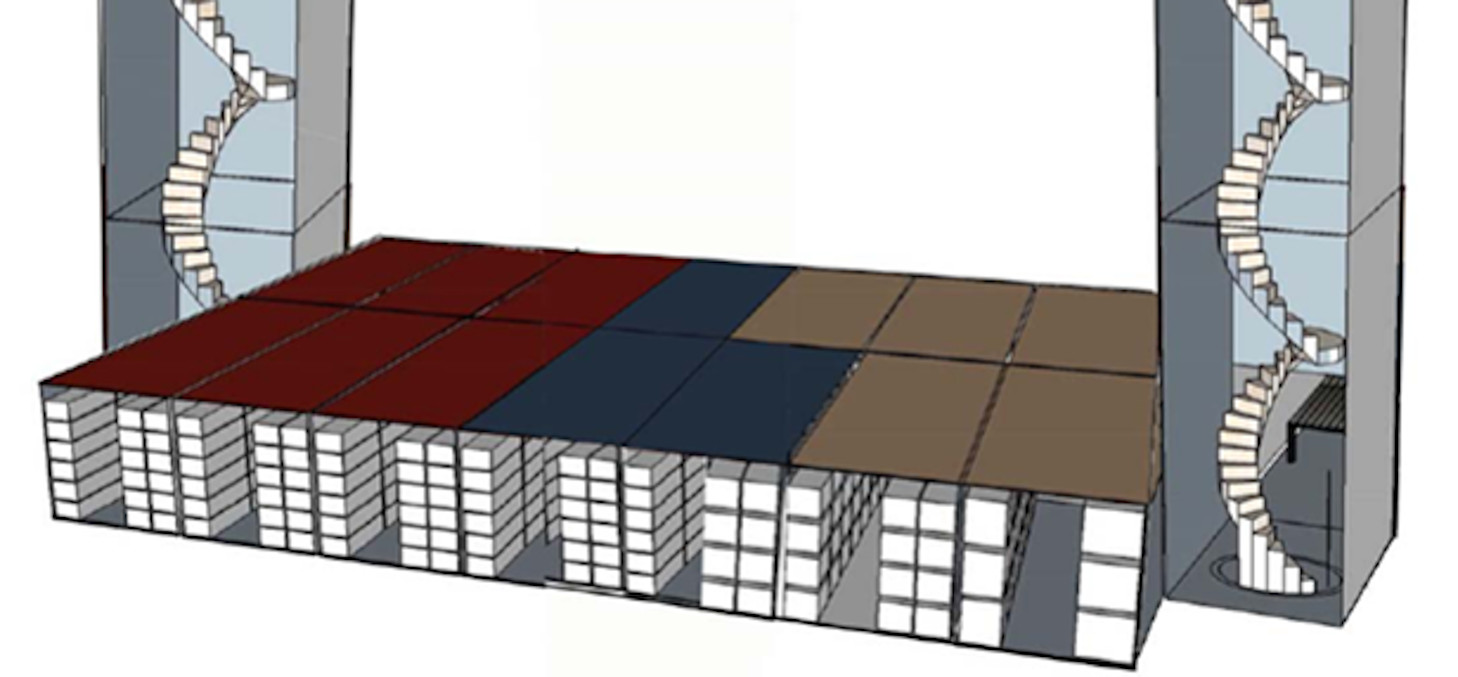
Project leaders envision that ice cores would be stored at the Concordia station in shipping containers inside a vault made of artificially blown snow. Researchers would access the cores by climbing down the spiral staircases at either end.
CREDIT: IPEV / FONDATION UGA
Not everyone thinks that cores need to go all the way to Antarctica. “I am not convinced that storing ice cores in Antarctica from these mountain tops is practical,” says Lonnie Thompson, a glaciologist at Ohio State University who pioneered studies of ice cores from glaciers outside of the polar regions. (His team’s ice cores are stored in freezers including at Ohio State, which have backup generators in case the power goes out.)
Flying scientists back and forth to Antarctica when they want to study samples isn’t very cost-effective, Thompson says. And the ongoing pandemic “brings home the simple fact to all of us as to just how far away Antarctica really is and no one has any guarantee of what the world will look like 100 years from now.”
Bess Koffman, a geologist at Colby College in Maine, also expresses doubts. “I’d be curious to know the long-term plan to make sure that someone goes back in 20 years, or further into the future, and maintains it,” she says. “Who’s going to be bulldozing the snow so you can get down to the shipping containers?”
Such questions highlight the challenge of putting a project intended to run for centuries into one of the most remote and international places in the world. In Norway, scientists have socked away agricultural seeds into a vault buried in the permafrost in Svalbard — but the Norwegian government owns and manages that project. The lack of national sovereignty in Antarctica makes Ice Memory more complicated.
Chappellaz notes that the project is endorsed by UNESCO, and that the Concordia base is subject to rules under the international Antarctic treaty system. These sorts of international governing bodies should be able to oversee a long-term project like Ice Memory, he says.
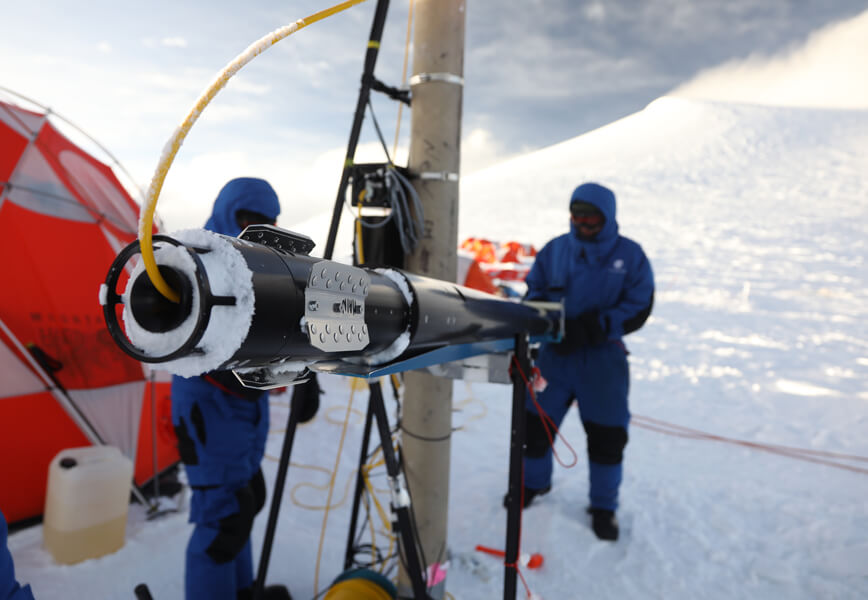
Drillers extract an ice core from near the summit of Nevado Illimani in Bolivia, during Ice Memory’s 2017 expedition there.
CREDIT: SARAH DEL BEN / WID TOUCH / FONDATION UGA
At present, the project is an effort of a patchwork of private funders and national research organizations, managed by an international steering committee and assisted by the University of Grenoble Alpes Foundation. While national research institutes provide people and resources, most financial support for drilling expeditions and analyses comes from companies and foundations that donate or pay for sponsorship. French, Italian and Swiss institutions are working to create a foundation that could raise more money from private donors.
With every passing year, the task of saving the memory of the ice gets harder. Already, melt water on some glaciers is finding its way from the surface into deeper ice, potentially wrecking the useful signal. Ice cores drilled from the Belukha Glacier in 2001 and 2003 showed layers where ice had melted and re-frozen in the upper part of the glacier, related to a sharp increase in summer temperatures. And temperatures some 50 meters inside the Col du Dôme glacier on Mont Blanc rose by 1.5 degrees C between 1994 and 2017, scientists reported in March in Cryosphere.
The Ice Memory team particularly wants to drill and preserve an ice core from Mount Kilimanjaro in Tanzania, which is home to Africa’s only glaciers that are suitable for paleoclimate studies. Despite plans for such an expedition, the Tanzanian government has yet to give permission. Schwikowski says if the Ice Memory team doesn’t get the core within five years, it will probably be too late. “It’s just falling apart up there,” she says.
“Time runs fast, as well as global warming,” Chappellaz says. “The more we wait, the more invaluable memories of our planet will be erased forever.”




